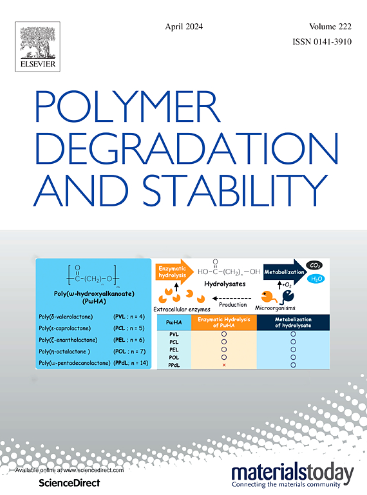Enhancing the liquid oxygen compatibility of epoxy resin by introducing a novel phosphorus / sulfur-containing flame retardant
IF 6.3
2区 化学
Q1 POLYMER SCIENCE
引用次数: 0
Abstract
The compatibility between epoxy resin with liquid oxygen (LOX) plays the critical role in the application of resin-based composite to LOX tanks of launch vehicles. A novel phosphorus/sulfur-containing flame retardant (DPAMT) was synthesized via a facile one-pot method with DOPO, p-hydroxybenzaldehyde and 2-Amino-5-mercapto-1,3,4-thiadiazole and used to enhance the LOX compatibility of epoxy resin. The chemical structure of DPAMT was confirmed by FTIR spectra, 1H NMR and 31P NMR spectra. The impact reaction sensitivity (IRS) index of modified epoxy resin decreased with increasing DPAMT content and reached zero (means being compatible with LOX) when the DPAMT content was up to 6 wt.%. TGA, LOI values, UL-94 test, Cone calorimeter test (CCT), XPS of residues after LOX impact and pyrolysis behavior of DPAMT were investigated to explore the mechanism of DPAMT affecting the LOX compatibility of epoxy resin. The results showed that DPAMT endowed epoxy resin with enhanced thermal stability and excellent flame retardancy. When the modified epoxy resin suffered impacts, the S·, PO· and PO2· radicals as well as SO2 exserting quenching effect by reacting with the active H·, OH· and O· radicals were released. Meanwhile, the P-containing acids and S-containing acids generated promoted the dehydration and carbonization of the epoxy resin to form protective charring layer. It was considered that the synthesized DPAMT was an effective addictive of epoxy resin to enhance the compatibility with LOX.
求助全文
约1分钟内获得全文
求助全文
来源期刊

Polymer Degradation and Stability
化学-高分子科学
CiteScore
10.10
自引率
10.20%
发文量
325
审稿时长
23 days
期刊介绍:
Polymer Degradation and Stability deals with the degradation reactions and their control which are a major preoccupation of practitioners of the many and diverse aspects of modern polymer technology.
Deteriorative reactions occur during processing, when polymers are subjected to heat, oxygen and mechanical stress, and during the useful life of the materials when oxygen and sunlight are the most important degradative agencies. In more specialised applications, degradation may be induced by high energy radiation, ozone, atmospheric pollutants, mechanical stress, biological action, hydrolysis and many other influences. The mechanisms of these reactions and stabilisation processes must be understood if the technology and application of polymers are to continue to advance. The reporting of investigations of this kind is therefore a major function of this journal.
However there are also new developments in polymer technology in which degradation processes find positive applications. For example, photodegradable plastics are now available, the recycling of polymeric products will become increasingly important, degradation and combustion studies are involved in the definition of the fire hazards which are associated with polymeric materials and the microelectronics industry is vitally dependent upon polymer degradation in the manufacture of its circuitry. Polymer properties may also be improved by processes like curing and grafting, the chemistry of which can be closely related to that which causes physical deterioration in other circumstances.
 求助内容:
求助内容: 应助结果提醒方式:
应助结果提醒方式:


